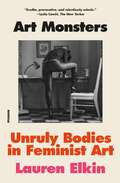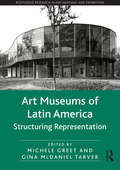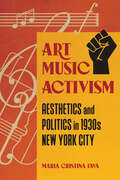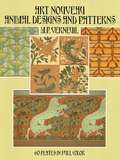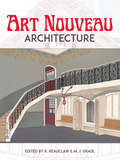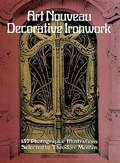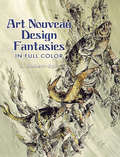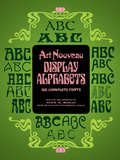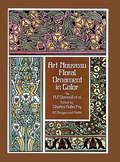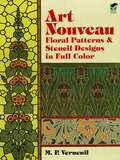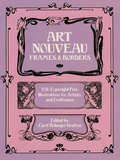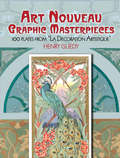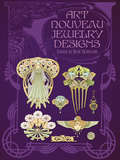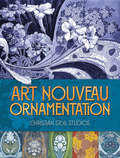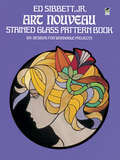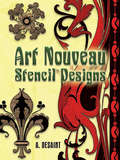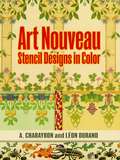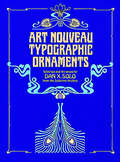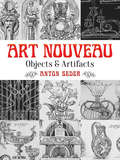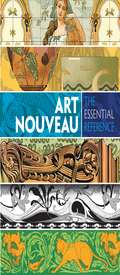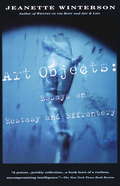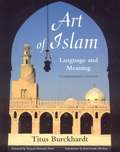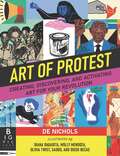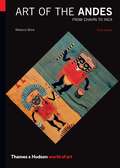- Table View
- List View
Art Monsters: Unruly Bodies in Feminist Art
by Lauren ElkinA Must-Read: Vogue, Nylon, Chicago Review of Books, Literary Hub, Frieze, The Millions, Publishers Weekly, InsideHook, The Next Big Idea Club,“[Lauren] Elkin is a stylish, determined provocateur . . . Sharp and cool . . . [Art Monsters is] exemplary. It describes a whole way to live, worthy of secret admiration.” —Maggie Lange, The Washington Post“Destined to become a new classic . . . Elkin shatters the truisms that have evolved around feminist thought.” —Chris Kraus, author of I Love Dick and After Kathy Acker: A Literary BiographyWhat kind of art does a monster make? And what if monster is a verb? Noun or a verb, the idea is a dare: to overwhelm limits, to invent our own definitions of beauty.In this dazzlingly original reassessment of women’s stories, bodies, and art, Lauren Elkin—the celebrated author of Flâneuse—explores the ways in which feminist artists have taken up the challenge of their work and how they not only react against the patriarchy but redefine their own aesthetic aims. How do we tell the truth about our experiences as bodies? What is the language, what are the materials, that we need to transcribe them? And what are the unique questions facing those engaged with female bodies, queer bodies, sick bodies, racialized bodies? Encompassing a rich genealogy of work across the literary and artistic landscape, Elkin makes daring links between disparate points of reference—among them Julia Margaret Cameron’s photography, Kara Walker’s silhouettes, Vanessa Bell’s portraits, Eva Hesse’s rope sculptures, Carolee Schneemann’s body art, Theresa Hak Kyung Cha’s trilingual masterpiece DICTEE—and steps into the tradition of cultural criticism established by Susan Sontag, Hélène Cixous, and Maggie Nelson. An erudite, potent examination of beauty and excess, sentiment and touch, the personal and the political, the ambiguous and the opaque, Art Monsters is a radical intervention that forces us to consider how the idea of the art monster might transform the way we imagine—and enact—our lives.
Art Museums of Latin America: Structuring Representation (Routledge Research in Art Museums and Exhibitions)
by Michele Greet Gina McDaniel TarverSince the late nineteenth century, art museums have played crucial social, political, and economic roles throughout Latin America because of the ways that they structure representation. By means of their architecture, collections, exhibitions, and curatorial practices, Latin American art museums have crafted representations of communities, including nation states, and promoted particular group ideologies. This collection of essays, arranged in thematic sections, will examine the varying and complex functions of art museums in Latin America: as nation-building institutions and instruments of state cultural politics; as foci for the promotion of Latin American modernities and modernisms; as sites of mediation between local and international, private and public interests; as organizations that negotiate cultural construction within the Latin American diaspora and shape constructs of Latin America and its nations; and as venues for the contestation of elitist and Eurocentric notions of culture and the realization of cultural diversity rooted in multiethnic environments.
Art Music Activism: Aesthetics and Politics in 1930s New York City (Music in American Life)
by Maria Cristina FavaSurrounded by the widespread misery of the Depression, left-leaning classical music composers sought a musical language that both engaged the masses and gave voice to their concerns. Maria Cristina Fava explores the rich creative milieu shaped by artists dedicated to using music and theater to advance the promotion, circulation, and acceptance of leftist ideas in 1930s New York City. Despite tensions between aesthetic and pragmatic goals, the people and groups produced works at the center of the decade’s sociopolitical and cultural life. Fava looks at the Composers’ Collective of New York and its work on proletarian music and workers’ songs before turning to the blend of experimentation and vernacular idioms that shaped the political use of music within the American Worker’s Theater Movement. Fava then reveals how composers and theater practitioners from these two groups achieved prominence within endeavors promoted by the Works Project Administration. Fava’s history teases out fascinating details from performances and offstage activity attached to works by composers such as Marc Blitzstein, Charles Seeger, Ruth Crawford Seeger, Elie Siegmeister, and Harold Rome. Endeavors encouraged avant-garde experimentation while nurturing innovations friendly to modernist approaches and an interest in non-western music. Blitzstein’s The Cradle Will Rock offered a memorable example that found popular success, but while the piece achieved its goals, it became so wrapped up in myths surrounding workers’ theater that critics overlooked Blitzstein’s musical ingenuity. Provocative and original, Art Music Activism considers how innovative classical composers of the 1930s balanced creative aims with experimentation, accessible content, and a sociopolitical message to create socially meaningful works.
Art Not by Eye: The Previously Sighted Visually Impaired Adult in Fine Arts Programs
by Yasha LisencoThe book, in two parts, deal with avenues for adventitiously blind adult, and the blind and severely visually impaired adults in the art program.
Art Nouveau Animal Designs and Patterns: 60 Plates in Full Color (Dover Pictorial Archive)
by M. P. VerneuilThis design collection includes all 60 full-color plates from L'animal dans la décoration, a rare turn-of-the-century portfolio by M. P. Verneuil. Meticulously reproduced from the originals, these plates offer a splendid demonstration of the application of animal forms to decorative art. Included are not only representations of such traditional decorative motifs as deer, swans, and peacocks, but also depictions of creatures seldom associated with beauty and ornamentation: bats, mice, lizards, insets, and other less conventional subjects. M. P. Verneuil was one of the leading lights of the influential Art Nouveau movement. His extraordinary inventiveness and draftsmanship can be seen here in detailed tableaux of animals and plants often wittily represented as interlocking parts of a larger decorative design. Butterflies, dragonflies, and bats float amid schematized flora; sea horses, flying fish, and gulls cavort in and above stylized seas; and a host of other fauna is similarly rendered with breathtaking imagination and ingenuity. Graphic artists, illustrators, craftspeople -- any student of design -- will want to have this book as an invaluable copyright-free source of artistic inspiration and as an eye-opening excursion into the rich and sensuous realms of the finest Art Nouveau design.
Art Nouveau Architecture
by R. Beauclair M. J. GradlPublished in Paris in 1902, these rare plates offer a unique source of details of the era's "modern" architecture. The 58 full-color images originally appeared in a short-lived periodical from the height of the Art Nouveau period. They provide an authentic source of information on how Art Nouveau influenced architectural design in the early twentieth century. Illustrations include windows, doorways, joists, railings, stairways, chimneys, ornamental woodwork, exterior decoration, elaborate ironwork, and much more. Additional plates depict interior and exterior views of these architectural elements in actual and planned buildings and rooms designed by architects of the period. Brief captions supply details for each plate. This treasury of rare illustrations and information represents a valuable resource for students of art history and the history of architecture as well as for architects and designers interested in Art Nouveau.
Art Nouveau Decorative Ironwork
by Theodore MentenAround the turn of the twentieth century, artists and craftsmen throughout Europe and America were profoundly affected by a new art style that took its inspiration from nature. Generally referred to as Art Nouveau, it exerted its influence on painters, illustrators, architects, ironworkers, furniture designers, interior decorators, potters, jewelry designers -- in fact, nearly every kind of artist-craftsman. While Art Nouveau is a broad and varied style, it is almost uniformly characterized by abstract, asymmetrical, curvilinear design. The thrust of this "new art" was twofold: to elevate the status of the "crafts" to equals and partners of the "fine arts"; and to bring a designed object into a harmonious relationship with its environment through the use of lines -- either expressive or controlling -- that were natural, vital, and most importantly, organic.Among the most imaginative realizations of these pervasive rhythms and serpentine patterns was the ironwork that was created during this period and still exists in major European cities (chiefly Paris and Brussels). Gates, railings, balconies, doorways, staircases, elevator cages, grilles, lampposts, and many other architectural features reveal the sinuous forms, foliate motifs, expert craftsmanship, and rich detail characteristic of the style.No other existing work documents so extensively and accurately the full range of Art Nouveau ironwork. Derived from now unavailable sources, this new anthology attests to the enduring qualities of both the design and its constructive material. Graphic designers, illustrators, architects, artists, and craftspeople of all disciplines will discover numerous ornamental ideas, authentic motifs, and design solutions among the 137 royalty-free photographic illustrations. Collectors and enthusiasts unfamiliar with this particular area of Art Nouveau will delight in the exquisite craftsmanship, ornamental felicities, and juxtaposition of strength and beauty as they observe these unyielding iron creations fashioned into delicate germinating buds and wandering tendrils. Captions for the photographs provide the building, city, architect, and designer of the ironwork. These latter include such notables as Victor Horta, Paul Hankar, Louis Majorelle, Charles Plumet, and Emile Robert. Their work and that of many others is preserved in this fine selection of photographs.
Art Nouveau Design Fantasies in Full Color
by J. Habert-DysElegant and distinctive, these eye-catching motifs combine a refined naturalism with the sophistication of Art Nouveau. Created during the early years of Art Nouveau, they reflect the late nineteenth century interest in Japanese art, as well as the fresh excitement of a blossoming movement that's remained fashionable for well over a century.Sixty-six full-color images feature luxurious patterns and ornaments designed for ceramics, furniture, textiles, walls, and ceilings. Superbly reproduced from a rare folio, these decorations were formerly available only in high-priced antiquarian editions. This inexpensive compilation makes them readily accessible and royalty-free to graphic artists, crafters, and designers.
Art Nouveau Display Alphabets
by Dan X. Solo100 complete fonts from Solo-type Typographers Catalog: upper and lower cases, alternate forms, swash forms, numerals, secondaries. Whiplash, organic, cursive, Orientalized, other styles. Beautiful, wide range of type fluidities suggest elegance, originality, grace, nearness to nature. Most not elsewhere.
Art Nouveau Floral Ornament in Color (Dover Pictorial Archive)
by Francis A. Davis Maurice P. VerneuilClassic portfolio includes 197 original designs, shown on 48 color plates: arrowhead, blackberry, buttercup, columbine, gourd, honeysuckle, iris, thistle, more; plus animal motifs: seahorses, kingfishers, peacocks, others, as well as some rarely associated with ornamental beauty such as rats and lizards. "An attractive and useful reference source." -- Theatre Craft.
Art Nouveau Floral Patterns and Stencil Designs in Full Color (Dover Pictorial Archive)
by M. P. VerneuilMagnificent collection of floral patterns and stencil designs, created by one of the movement's finest artists, includes 120 images of graceful garden flowers --foxglove, hollyhocks, columbine, lilies, among others, and 39 stencil designs of blossoming trees, reeds, mushrooms, oak leaves, peacocks, and more.
Art Nouveau Frames and Borders: 250 Copyright-free Illustrations For Artists And Craftsmen (Dover Pictorial Archive)
by Carol Belanger GraftonIndispensable collection for enhancing menus, invitations, ad copy, greeting cards, catalogs -- almost any graphic project -- includes 199 black-and-white designs, among them crisply rendered floral and foliate motifs, butterflies and peacocks, female figures and sensuous cherubs, asymmetrical shapes and undulating lines, all in a variety of shapes and sizes.
Art Nouveau Graphic Masterpieces: 100 Plates From "La Decoration Artistique" (Calla Editions)
by Henry GuedyPublished in Paris before World War I, these decorative Art Nouveau graphics originally appeared in a now-rare periodical, La Decoration Artistique. This compilation presents 100 full-color plates in a beautiful assortment of period designs that will prove essential to collectors of the era's best and hardest-to-find illustrations. A splendid variety of images includes headpieces, typographical banners, and other designs rendered in the distinctive Art Nouveau style, all embellished with naturalistic motifs, from parrots and peacocks to sinuous vines and flowers in full bloom. Other illustrations feature storefront signage for bakeries and cafés; decorative friezes of theatrical masks and grapevines; borders of blossoms, books, and birds; stenciled decorations for fire screens; and corner and ceiling ornaments. Art aficionados, designers, artists, art students, and anyone with a taste for Art Nouveau will delight in this extraordinary collection, which offers a lasting source of inspiration and pleasure.
Art Nouveau Jewelry Designs
by Rene BeauclairAt the turn of the twentieth century, the Art Nouveau movement swept the world of decorative arts toward an excitingly modern direction. Inspired by both organic and geometric forms, the new trend abandoned historical styles in favor of flowing, natural forms accented by angular contours. Art Nouveau's curves and floral and animal motifs were particularly suited to adaptations in precious stones and rare metals. The elegant, royalty-free illustrations of this collection, reprinted in their original colors from a rare German edition, offer authentic representations of the craftsmanship and imaginative qualities involved in the creation of Art Nouveau jewelry.This sumptuous assortment presents more than 300 pendants, combs, rings, bracelets, brooches, buttons, clasps, and earrings. The exquisitely detailed jewelry and accessories feature lilies, morning glories, and other floral motifs as well as butterflies, seahorses, birds, and a host of fanciful creatures. René Beauclair, a renowned Art Nouveau designer, includes his own works as well as those of André Petitjean, Jules Armbruster, Paul Liénard, Emile Jammes, and Paul F. Follot. The striking, royalty-free illustrations are readily adaptable to any design use and will serve as a source of inspiration for jewelry designers and crafters of all kinds.
Art Nouveau Ornamentation
by Christian StollThis splendid source of authentic Art Nouveau designs presents more than 90 breathtaking plates, ranging from single to full color, selected from rare originals of a renowned German studio's stock portfolios.
Art Nouveau Stained Glass Pattern Book
by Ed Sibbett Jr.Stained glass workers will welcome this book containing 104 authentic Art Nouveau patterns newly rendered by Ed Sibbett, Jr.In the typical Art Nouveau style are 104 designs in this book: florals with stem and leaf patterns; sensuous women with billowing hair, dresses, and exquisite headpieces; fish; butterflies; peacocks; Beardsley-like women in profile wearing masks; and many, many others. Some of these designs are intermediate to advanced and will be a challenge to skilled craftsmen, while others are simple enough for beginners in the field. They can be used whole or in part for windows, panels, lampshades, mirrors, frames, mobiles, or other craft projects.
Art Nouveau Stencil Designs (Dover Pictorial Archive)
by A. DesaintThis unusual collection of stencil designs showcases the sinuous elegance of Art Nouveau, with 44 plates dating from the 1920s. Inspired by interior and exterior architectural ornaments of buildings in France and Britain, the designs are meticulously reproduced from a rare vintage publication.Attractive patterns range from decorations for churches, drawing rooms, nurseries, and everything in between, including halls, galleries, and corners. The elaborate borders, friezes, and festoons include exquisite images of children, animals, birds, rosettes, and heraldic designs. These finely detailed, royalty-free patterns are an invaluable resource, perfect for adding a distinctive note to fabrics, stained glass, wallpaper, and a host of other art and craft projects. Browsers and devotees of the Art Nouveau style will also appreciate this treasury of striking stencil designs.
Art Nouveau Stencil Designs in Color (Dover Pictorial Archive)
by A. Charayron Leon DurandDrawn from a rare French volume, this gallery of delicate multicolor stenciling in the Art Nouveau style features the use of pochoir, a unique method that was popular in Paris during the early part of the twentieth century. Distinctive for its clear, sharp lines, vibrant colors, and textured surfaces, pochoir stenciling was used in fashion journals, interiors, architecture, and industrial design--and offers a host of applications in those areas today. Steeped in the flowing, graceful style of Art Nouveau, this remarkable array of colorful illustrations showcases panels, friezes, walls, and ceilings, embellished with such natural delights as wild roses and nasturtiums, pears and grapes, seagulls and geese, rabbits and roosters, and children playing in country settings. The high-quality, royalty-free art will prove to be an abundant source of inspiration for crafters, decorators, and graphic designers.
Art Nouveau Typographic Ornaments (Dover Pictorial Archive)
by Dan X. SoloOver 800 Art-Nouveau florals, swirls, women, animals, borders, scrolls, wreaths, spots and dingbats, copyright-free.
Art Nouveau: Objects and Artifacts (Dover Pictorial Archive)
by Anton SederA revolutionary reaction to the eclectic historical styles of nineteenth-century art, the turn-of-the-century Art Nouveau movement drew much of its inspiration from nature. Applying its sinuous, curvilinear motifs to the decorative arts, graphics, architecture, sculpture, and painting, artists and crafters attempted to create a style suitable for a "modern" age. This treasury of rare Art Nouveau decorative ornaments offers an unusual selection of the genre's most strikingly imaginative graphics. Originally published in Paris in 1899 and sold by subscription, the collection features fifty full-page plates depicting a rich profusion of everyday items rendered in the distinctive Art Nouveau style. Intricate patterns of flowers, vines, faces, and other designs decorate scores of objects made of metal, ceramic, and glass: pitchers and vases, cutlery, walking sticks, jewelry, and other objects and artifacts. A source of authentic Art Nouveau graphics, this compilation will serve as an inspiration for artists, illustrators, and designers.
Art Nouveau: The Essential Reference (Dover Pictura Electronic Clip Art Ser.)
by Carol Belanger Grafton"This is a gorgeous book, ideal for any lover of Art Nouveau." --bookaddictionDover's extensive library of Art Nouveau graphic art and typography serves as the source for this comprehensive volume, which features hundreds of magnificent full-color and black-and-white illustrations. Images by virtually every key artist of the Art Nouveau movement include the work of Alphonse Mucha, E. A. Seguy, Aubrey Beardsley, Koloman Moser, Max Benirschke, and M. P. Verneuil. Selections from rare books and portfolios of the period include works never reprinted since their initial publication. This book also reprints material from the major Art Nouveau periodicals, including Jugend, The Studio, Dekorative Vorbilder, and The Keramic Studio. Detailed bibliographical information concerning every source - including biographical details of each artist - makes this collection a vital reference tool as well as a stunning compendium of significant and beautiful Art Nouveau graphics. Students of graphic art, typography, and illustration, as well as graphic designers and advertising professionals, will prize this remarkable resource.
Art Objects: Essays on Ecstasy and Effrontery
by Jeanette WintersonIn these ten intertwined essays, one of our most provocative young novelists proves that she is just as stylish and outrageous an art critic. For when Jeanette Winterson looks at works as diverse as the Mona Lisa and Virginia Woolf's The Waves, she frees them from layers of preconception and restores their power to exalt and unnerve, shock and transform us."Art Objects is a book to be admired for its effort to speak exorbitantly, urgently and sometimes beautifully about art and about our individual and collective need for serious art."--Los Angeles Times
Art Of Islam: Language And Meaning
by Titus BurckhardtKnown as an expert on Islam, Sufism, and Islamic arts & crafts, Burckhardt presents in-depth analyses of seminal examples of Islamic architecture, from Spain and Morocco to Persia and India. He examines Koranic calligraphy and illumination, arabesque, carpets and rugs, Persian miniatures, and much more while making illuminating comparisons with Christian, Hindu, and Buddhist art. Beautifully illustrated in color, this masterpiece is presented in a revised, commemorative edition containing 285 new illustrations and a new Introduction.
Art Of Protest: Creating, Discovering, And Activating Art For Your Revolution
by De NicholsFrom Keith Haring to Extinction Rebellion, the civil rights movement to Black Lives Matter, what does a revolution look like? Discover the power of words and images in this thought-provoking look at protest art by highly acclaimed artivist De Nichols. From the psychedelic typography used in "Make Love Not War" posters of the '60s to the solitary raised fist, some of the most memorable and striking protest artwork from across the world and throughout history deserves a long, hard look. Readers can explore each piece of art to understand how color, symbolism, technique, and typography play an important role in communication. Guided by activist, lecturer, and speaker De Nichols's powerful narrative and stunningly illustrated by a collaboration of young artists, this volume also has plenty of tips and ideas for creating your own revolutionary designs. This is a fully comprehensive look at the art of protest.
Art Of The Andes: From Chavín To Inca
by Rebecca StoneThis wide-ranging survey has established itself as the best singlevolume introduction to Andean art and architecture, and is an essential guide to pre-Columbian Peru, Ecuador, and Bolivia for the general reader, student, traveler, and artist alike. Describing the strikingly varied artistic achievements of the Chavín, Paracas, Moche, Nasca, Chimu, and Inca cultures, among others, Rebecca Stone has rewritten and expanded the text throughout, touching on many of the recent discoveries and advances in the field. <p><p> Throughout this fully revised third edition, Stone demonstrates how the Andean peoples adapted and refined their aesthetic response to a formidable and demanding environment and explored the interface between the terrestrial and the otherworldly according to the value they placed on shamanic religious experience.
